Municipal Solid Waste Management through Sustainable Landfilling: In View of the Situation in Karachi, Pakistan
Abstract
1. Introduction
2. MSW Management Situation and Climate Conditions in Karachi, Pakistan
2.1. Geographical Location
2.2. Weather Conditions
2.3. MSW Management and Treatment
2.3.1. MSW Generation
2.3.2. MSW Composition
2.3.3. MSW Collection and Transfer
2.3.4. MSW Recovery and Recycling
2.3.5. MSW Disposal
3. Materials and Methods
3.1. MSW Sample Modelling
3.2. Landfill Simulation Experiment Methodology
3.2.1. Pre-Aeration Operation
3.2.2. Anaerobic Operation
3.2.3. Post-Aeration
3.2.4. Completion of the Landfill Simulation Reactor Experiment
3.3. Assessment of GHG Emission Potential and Biostabilization of MSW
3.3.1. Gas Formation Potential Assessment (GP21)
3.3.2. Respiration Activity (RI4 and RI7)
4. Results and Discussion
4.1. Production and Composition of Landfill Gas during Anaerobic Operations
4.2. Gas Formation Potential Assessment (GP21)
4.3. Respiration Activity (RI4 and RI7)
4.4. Carbon Balance
5. Conclusions
Author Contributions
Funding
Institutional Review Board Statement
Informed Consent Statement
Data Availability Statement
Acknowledgments
Conflicts of Interest
References
- Ngoc, U.N.; Schnitzer, H. Sustainable solutions for solid waste management in Southeast Asian countries. Waste Manag. 2009, 29, 1982–1995. [Google Scholar] [CrossRef]
- Gautam, M.; Agrawal, M. Greenhouse Gas Emissions from Municipal Solid Waste Management: A Review of Global Scenario. In Carbon Footprint Case Studies; Springer: Singapore, 2021; pp. 123–160. [Google Scholar] [CrossRef]
- Cetrulo, T.B.; Marques, R.C.; Cetrulo, N.M.; Pinto, F.S.; Moreira, R.M.; Mendizábal-Cortés, A.D.; Malheiros, T.F. Effectiveness of solid waste policies in developing countries: A case study in Brazil. J. Clean. Prod. 2018, 205, 179–187. [Google Scholar] [CrossRef]
- Aleluia, J.; Ferrão, P. Characterization of urban waste management practices in developing Asian countries: A new analytical framework based on waste characteristics and urban dimension. Waste Manag. 2016, 58, 415–429. [Google Scholar] [CrossRef] [PubMed]
- Ziraba, A.K.; Haregu, T.N.; Mberu, B. A review and framework for understanding the potential impact of poor solid waste management on health in developing countries. Arch. Public Health 2016, 74, 55. [Google Scholar] [CrossRef] [PubMed]
- Marshall, R.E.; Farahbakhsh, K. Systems approaches to integrated solid waste management in developing countries. Waste Manag. 2013, 33, 988–1003. [Google Scholar] [CrossRef] [PubMed]
- McDougall, F.R.; White, P.R.; Franke, M.; Hindle, P. Integrated Solid Waste Management: A Life Cycle Inventory; John Wiley & Sons: Hoboken, NJ, USA, 2012; ISBN 0470999667. [Google Scholar]
- Ravichandran, C.; Venkatesan, G. Toward Sustainable Solid Waste Management—Challenges and Opportunities. Available online: https://www.sciencedirect.com/science/article/pii/B9780128221341000038 (accessed on 28 April 2021).
- Elnaas, A. Actual Situation and Approach for Municipal Solid Waste Treatment in the Arab Region. Ph.D. Thesis, Rostock University, Rostock, Germany, 2015. Available online: https://rosdok.uni-rostock.de/file/rosdok_disshab_0000001580/rosdok_derivate_0000034733/Dissertation_Elnaas_2016.pdf (accessed on 28 April 2021).
- Yan, M.; Agamuthu, P.; Waluyo, J. Challenges for Sustainable Development of Waste to Energy in Developing Countries. Waste Manag. Res. 2020, 38, 229–231. [Google Scholar] [CrossRef] [PubMed]
- Weng, Y.C.; Fujiwara, T.; Houng, H.J.; Sun, C.H.; Li, W.Y.; Kuo, Y.W. Management of landfill reclamation with regard to biodiversity preservation, global warming mitigation and landfill mining: Experiences from the Asia-Pacific region. J. Clean. Prod. 2015, 104, 364–373. [Google Scholar] [CrossRef]
- Mir, I.S.; Cheema, P.P.S.; Singh, S.P. Implementation analysis of solid waste management in Ludhiana city of Punjab. Environ. Chall. 2021, 2, 100023. [Google Scholar] [CrossRef]
- Ritzkowski, M.; Heerenklage, J.; Stegmann, R. An overview on techniques and regulations of mechanical-biological pre-treatment of municipal solid waste. Clean Air 2006, 2, 57–68. [Google Scholar]
- Kaza, S.; Yao, L.; Bhada-Tata, P.; Van Woerden, F. What a Waste 2.0: A Global Snapshot of Solid Waste Management to 2050; The World Bank: Washington, DC, USA, 2018. [Google Scholar]
- Loizia, P.; Voukkali, I.; Zorpas, A.A.; Navarro Pedreño, J.; Chatziparaskeva, G.; Inglezakis, V.J.; Vardopoulos, I.; Doula, M. Measuring the level of environmental performance in insular areas, through key performed indicators, in the framework of waste strategy development. Sci. Total Environ. 2021, 753, 141974. [Google Scholar] [CrossRef]
- Molina, R.A.; Catan, I. Solid Waste Management Awareness and Practices among Senior High School Students in a State College in Zamboanga City, Philippines. Aquademia 2021, 5, ep21001. [Google Scholar] [CrossRef]
- Zia, U.U.R.; ur Rashid, T.; Ali, M.; Awan, W.N. Techno-economic assessment of energy generation through municipal solid waste: A case study for small/medium size districts in Pakistan. Waste Dispos. Sustain. Energy 2020, 2, 337–350. [Google Scholar] [CrossRef]
- Sohoo, I.; Ritzkowski, M.; Sohu, Z.A.; Cinar, S.Ö.; Chong, Z.K.; Kuchta, K. Estimation of methane production and electrical energy generation from municipal solid waste disposal sites in Pakistan. Energies 2021, 14, 2444. [Google Scholar] [CrossRef]
- Korai, M.S.; Mahar, R.B.; Uqaili, M.A. The feasibility of municipal solid waste for energy generation and its existing management practices in Pakistan. Renew. Sustain. Energy Rev. 2017, 72, 338–353. [Google Scholar] [CrossRef]
- Ministry of Climate Change, Government of Pakistan. Pakistan’s Second National Communication on Climate Change to Unite Nations Framework Convention on Climate Change (UNFCCC). 2018. Available online: http://www.gcisc.org.pk/SNC_Pakistan.pdf (accessed on 28 April 2021).
- Korai, M.S.; Ali, M.; Lei, C.; Mahar, R.B.; Yue, D. Comparison of MSW management practices in Pakistan and China. J. Mater. Cycles Waste Manag. 2019, 22.2, 443–453. [Google Scholar] [CrossRef]
- Zuberi, M.J.S.; Ali, S.F. Greenhouse effect reduction by recovering energy from waste landfills in Pakistan. Renew. Sustain. Energy Rev. 2015, 44, 117–131. [Google Scholar] [CrossRef]
- Miezah, K.; Obiri-Danso, K.; Kádár, Z.; Fei-Baffoe, B.; Mensah, M.Y. Municipal solid waste characterization and quantification as a measure towards effective waste management in Ghana. Waste Manag. 2015, 46, 15–27. [Google Scholar] [CrossRef]
- Aslam, S.; Ali, F.; Naseer, A.; Sheikh, Z. Application of material flow analysis for the assessment of current municipal solid waste management in Karachi, Pakistan. Waste Manag. Res. 2021. [Google Scholar] [CrossRef]
- Ayeleru, O.O.; Fajimi, L.I.; Oboirien, B.O.; Olubambi, P.A. Forecasting municipal solid waste quantity using artificial neural network and supported vector machine techniques: A case study of Johannesburg, South Africa. J. Clean. Prod. 2021, 289, 125671. [Google Scholar] [CrossRef]
- Abbasi, H.; Lu, X.; Zhao, G. An Overview of Karachi Solid Waste Disposal Sites and Environs. J. Sci. Res. Rep. 2015, 6, 294–303. [Google Scholar] [CrossRef]
- Sabir, W.; Waheed, S.N.; Afzal, A.; Umer, S.M.; Rehman, S. A Study of Solid Waste Management in Karachi City. J. Educ. Soc. Sci. 2016, 4, 144–156. [Google Scholar] [CrossRef][Green Version]
- Khan, S.; Alvarez, L.C.M.; Wei, Y. Sustainable Management of Municipal Solid Waste under Changing Climate: A Case Study of Karachi, Pakistan. Asian J. Environ. Sci. Technol. 2018, 2, 1–9. [Google Scholar]
- Mahmood, H.; Khan, M.M. Urban Solid Waste Management in Karachi, Pakistan. Int. J. Econ. Environ. Geol. 2019, 10, 78–83. [Google Scholar] [CrossRef]
- Shah, S.Z.A.; Nawaz, Z.; Nawaz, S.; Carder, G.; Ali, M.; Soomro, N.; Compston, P.C. The Role and Welfare of Cart Donkeys Used in Waste Management in Karachi, Pakistan. Animals 2019, 9, 159. [Google Scholar] [CrossRef]
- Shahid, M.; Nergis, Y.; Siddiqui, S.A.; Farooq Choudhry, A. Environmental impact of municipal solid waste in Karachi city. World Appl. Sci. J. 2014, 29, 1516–1526. [Google Scholar] [CrossRef]
- Nwaokorie, K.J.; Bareither, C.A.; Mantell, S.C.; Leclaire, D.J. The influence of moisture enhancement on landfill gas generation in a full-scale landfill. Waste Manag. 2018, 79, 647–657. [Google Scholar] [CrossRef]
- Sohoo, I.; Ritzkowski, M.; Heerenklage, J.; Kuchta, K. Biochemical methane potential assessment of municipal solid waste generated in Asian cities: A case study of Karachi, Pakistan. Renew. Sustain. Energy Rev. 2021, 135, 110175. [Google Scholar] [CrossRef]
- Karachi Development Authority Karachi the Gateway to Pakistan. Available online: http://www.kda.gos.pk/Contents.aspx?id=14 (accessed on 1 February 2019).
- Pakistan Bureau of Statistics, Government. of Pakistan. 6th Pakistan Population and Housing Census 2017; Pakistan Bureau of Statistics, Government of Pakistan: Islamabad, Pakistan, 2017.
- Salma, S.; Rehman, S.; Shah, M.A. Rainfall Trends in Different Climate Zones of Pakistan. Pak. J. Meteorol. 2012, 9, 37–47. [Google Scholar]
- World Meteorological Organization World Weather Information Service. Available online: http://worldweather.wmo.int/en/city.html?cityId=892 (accessed on 23 May 2017).
- Alibardi, L.; Cossu, R. Leachate Generation Modeling; Solid Waste Landfilling (Concepts, Processes, Technologies); Elsevier Inc.: Oxford, UK, 2018; pp. 229–245. [Google Scholar]
- Khan, S.; Ul Hasan, M. Evapotranspiration Distribution and Variation of Pakistan (1931–2015). Ann. Valahia Univ. Targoviste Geogr. Ser. 2017, 17, 184–197. [Google Scholar] [CrossRef][Green Version]
- Qureshi, S. The fast growing megacity Karachi as a frontier of environmental challenges: Urbanization and contemporary urbanism issues. J. Geogr. Reg. Plan. 2010, 3, 306–321. [Google Scholar]
- Mehdi, M.R. Appraisals of Noise Pollution, Traffic and Land Use Patterns in Metropolitan Karachi through GIS and Remote Sensing Techniques. Ph.D. Thesis, Karachi University, Karachi, Pakistan, 2002. Available online: http://prr.hec.gov.pk/jspui/bitstream/123456789/4937/1/8.pdf (accessed on 28 April 2021).
- Kazmi, S.J.H.; Mehdi, R.; Arsalan, M.H. Karachi: Environmental Challenges of a Mega City; South Asian Mega Cities; Cambridge University Press: New Delhi, India, 2008; pp. 23–36. [Google Scholar]
- Haq, M. The Rise of Karachi as a Mega-City: Issues and Challenges. Available online: http://www.mhhdc.org (accessed on 28 April 2021).
- The World Bank. Transforming Karachi into a Livable and Competitive Megacity a City Diagnostic and Transformation Strategy; The World Bank: Washington, DC, USA, 2018. [Google Scholar]
- SSWMB. Solid Waste Emergency and Efficiency Project (SWEEP) Sindh Solid Waste Management Board Government of Sindh; SSWMB: Karachi, Pakistan, 2020. [Google Scholar]
- Korai, M.S.; Mahar, R.B.; Uqaili, M.A.; Brohi, K.M. Assessment of municipal solid waste management practices and Energy recovery potential in Pakistan. In Proceedings of the 14th International Conference on Environmental Science and Technology, Rhodes, Greece, 3–5 September 2015. [Google Scholar]
- Here’s What You Need to Know about Solid Waste Management in Karachi. 2019. Available online: http://Zameen.com/ (accessed on 2 March 2020).
- Rodić, L.; Wilson, D.C. Resolving governance issues to achieve priority sustainable development goals related to solid waste management in developing countries. Sustainability 2017, 9, 404. [Google Scholar] [CrossRef]
- SSWMB. Tenders. Available online: http://sswmb.gos.pk/cms/?page_id=1617 (accessed on 28 April 2021).
- Ali, D.M.; Hasan, A. Integrating Recycling and Disposal System for Solid Waste Management in Karachi; Urban Resource Center: Karachi, Pakistan, 2001. [Google Scholar]
- City District Government Karachi—CDGK. Karachi Stretegic Development Plan 2020; City District Government Karachi: Karachi, Pakistan, 2007.
- Shah, S.A. Analyzing site suitability for solid waste disposal through GIS multi-criteria decision making hierarchy process. 3C Tecnol. Innov. Apl. Pyme 2019, 7, 65–80. [Google Scholar] [CrossRef]
- Olivier, F.; Gourc, J.-P. Hydro-mechanical behavior of municipal solid waste subject to leachate recirculation in a large-scale compression reactor cell. Waste Manag. 2007, 27, 44–58. [Google Scholar] [CrossRef]
- Erses, A.S.; Onay, T.T.; Yenigun, O. Comparison of aerobic and anaerobic degradation of municipal solid waste in bioreactor landfills. Bioresour. Technol. 2008, 99, 5418–5426. [Google Scholar] [CrossRef]
- Reddy, K.R.; Hettiarachchi, H.; Gangathulasi, J.; Bogner, J.E. Geotechnical properties of municipal solid waste at different phases of biodegradation. Waste Manag. 2011, 31, 2275–2286. [Google Scholar] [CrossRef] [PubMed]
- Intrakamhaeng, V.; Clavier, K.A.; Liu, Y.; Townsend, T.G. Antimony mobility from E-waste plastic in simulated municipal solid waste landfills. Chemosphere 2020, 241, 125042. [Google Scholar] [CrossRef]
- Sohoo, I.; Ritzkowski, M.; Kuchta, K. Evaluation of behavior of waste disposal sites in Karachi, Pakistan and effects of enhanced leaching on their emission potential. Detritus 2019, 7, 96–103. [Google Scholar] [CrossRef]
- Ritzkowski, M.; Heyer, K.U.; Stegmann, R. Fundamental processes and implications during in situ aeration of old landfills. Waste Manag. 2006, 26, 356–372. [Google Scholar] [CrossRef] [PubMed]
- Sohoo, I.; Ritzkowski, M.; Kuchta, K. Influence of moisture content and leachate recirculation on oxygen consumption and waste stabilization in post aeration phase of landfill operation. Sci. Total Environ. 2021, 773, 145584. [Google Scholar] [CrossRef]
- Ritzkowski, M.; Walker, B.; Kuchta, K.; Raga, R.; Stegmann, R. Aeration of the teuftal landfill: Field scale concept and lab scale simulation. Waste Manag. 2016, 55, 99–107. [Google Scholar] [CrossRef] [PubMed]
- Ali, M.; Zhang, J.; Raga, R.; Lavagnolo, M.C.; Pivato, A.; Wang, X.; Zhang, Y.; Cossu, R.; Yue, D. Effectiveness of aerobic pretreatment of municipal solid waste for accelerating biogas generation during simulated landfilling. Front. Environ. Sci. Eng. 2018, 12, 1–9. [Google Scholar] [CrossRef]
- Salati, S.; Scaglia, B.; di Gregorio, A.; Carrera, A.; Adani, F. Mechanical biological treatment of organic fraction of MSW affected dissolved organic matter evolution in simulated landfill. Bioresour. Technol. 2013, 142, 115–120. [Google Scholar] [CrossRef]
- Cossu, R.; Morello, L.; Raga, R.; Cerminara, G. Biogas production enhancement using semi-aerobic pre-aeration in a hybrid bioreactor landfill. Waste Manag. 2016, 55, 83–92. [Google Scholar] [CrossRef]
- Ni, Z.; Liu, J.; Girotto, F.; Cossu, R.; Qi, G. Targeted modification of organic components of municipal solid waste by short-term pre-aeration and its enhancement on anaerobic degradation in simulated landfill bioreactors. Bioresour. Technol. 2016, 216, 250–259. [Google Scholar] [CrossRef] [PubMed]
- Sohoo, I.; Ritzkowski, M.; Kuchta, K.; Cinar, S.Ö. Environmental Sustainability Enhancement of Waste Disposal Sites in Developing Countries through Controlling Greenhouse Gas Emissions. Sustainability 2021, 13, 151. [Google Scholar] [CrossRef]
- Fellner, J.; Döberl, G.; Allgaier, G.; Brunner, P.H. Comparing field investigations with laboratory models to predict landfill leachate emissions. Waste Manag. 2009, 29, 1844–1851. [Google Scholar] [CrossRef] [PubMed]
- Leuschner, A. Enhancement of Degradation: Laboratory Scale Experiments. In Sanitary Landfilling: Process, Technology and Environmental Impact; Academic Press Inc.: San Diego, CA, USA, 2012; p. 83. ISBN 0121742555. [Google Scholar]
- Hettiaratchi, P.; Jayasinghe, P.; Tay, J.H.; Yadav, S. Recent advances of biomass waste to gas using landfill bioreactor technology—A review. Curr. Org. Chem. 2015, 19, 413–422. [Google Scholar] [CrossRef]
- Bilgili, M.S.; Demir, A.; Varank, G. Evaluation and modeling of biochemical methane potential (BMP) of landfilled solid waste: A pilot scale study. Bioresour. Technol. 2009, 100, 4976–4980. [Google Scholar] [CrossRef]
- Filer, J.; Ding, H.H.; Chang, S. Biochemical Methane Potential (BMP) Assay Method for Anaerobic Digestion Research. Water 2019, 11, 921. [Google Scholar] [CrossRef]
- Angelidaki, I.; Alves, M.; Bolzonella, D.; Borzacconi, L.; Campos, J.L.; Guwy, A.J.; Kalyuzhnyi, S.; Jenicek, P.; Van Lier, J.B. Defining the biomethane potential (BMP) of solid organic wastes and energy crops: A proposed protocol for batch assays. Water Sci. Technol. 2009, 59, 927–934. [Google Scholar] [CrossRef]
- Labatut, R.A.; Angenent, L.T.; Scott, N.R. Biochemical methane potential and biodegradability of complex organic substrates. Bioresour. Technol. 2011, 102, 2255–2264. [Google Scholar] [CrossRef] [PubMed]
- Fermentation of Organic Materials—Characterisation of the Substrate, Sampling, Collection of Material Data, Fermentation Tests. Available online: https://www.beuth.de/de/technische-regel/vdi-4630/244849582?websource=vdin (accessed on 28 April 2021).
- Heerenklage, J.; Stegmann, R. Analytical Methods for the Determination of the Biological Activity of Organic Biomass. Available online: https://ask-eu.de/Artikel/8024/Analytical-Methods-for-the-Determination-of-the-Biological-Activity-of-Organic-Biomass.htm (accessed on 28 April 2021).
- Ordinance on Environmentally Compatible Storage of Waste from Human Settlements and on Biological Waste-Treatment Facilities. Available online: https://www.bmuv.de/fileadmin/bmu-import/files/pdfs/allgemein/application/pdf/ablagerungsverordnung.pdf (accessed on 28 April 2021).
- Cossu, R.; Raga, R.; Rossetti, D. The PAF model: An integrated approach for landfill sustainability. Waste Manag. 2003, 23, 37–44. [Google Scholar] [CrossRef]
- Francois, V.; Feuillade, G.; Matejka, G.; Lagier, T.; Skhiri, N. Leachate recirculation effects on waste degradation: Study on columns. Waste Manag. 2007, 27, 1259–1272. [Google Scholar] [CrossRef] [PubMed]
- Rovers, G.J.F.F.A. Gas production during refuse decomposition. Water. Air. Soil Pollut. 1973, 2, 483–495. [Google Scholar] [CrossRef]
- Ritzkowski, M. Clean Development Mechanism (CDM) in Landfilling. Solid Waste Landfill. 2018, 2, 1141–1152. [Google Scholar] [CrossRef]
- Ritzkowski, M.; Stegmann, R. Landfill aeration within the scope of post-closure care and its completion. Waste Manag. 2013, 33, 2074–2082. [Google Scholar] [CrossRef]
- Ritzkowski, M.; Stegmann, R. Controlling greenhouse gas emissions through landfill in situ aeration. Int. J. Greenh. Gas Control 2007, 1, 281–288. [Google Scholar] [CrossRef]
- Bilgili, M.S.; Demir, A.; Özkaya, B. Influence of leachate recirculation on aerobic and anaerobic decomposition of solid wastes. J. Hazard. Mater. 2007, 143, 177–183. [Google Scholar] [CrossRef] [PubMed]
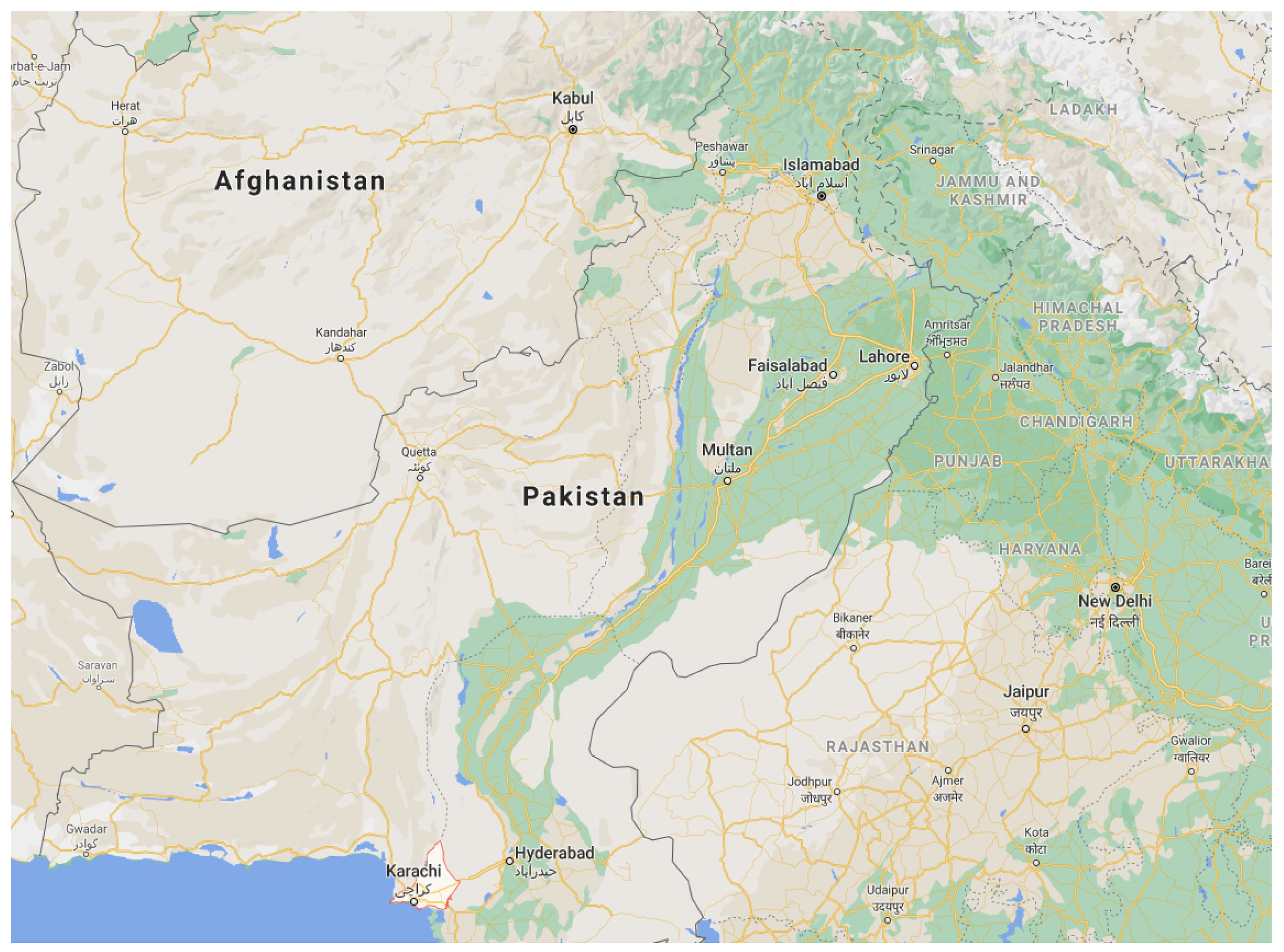

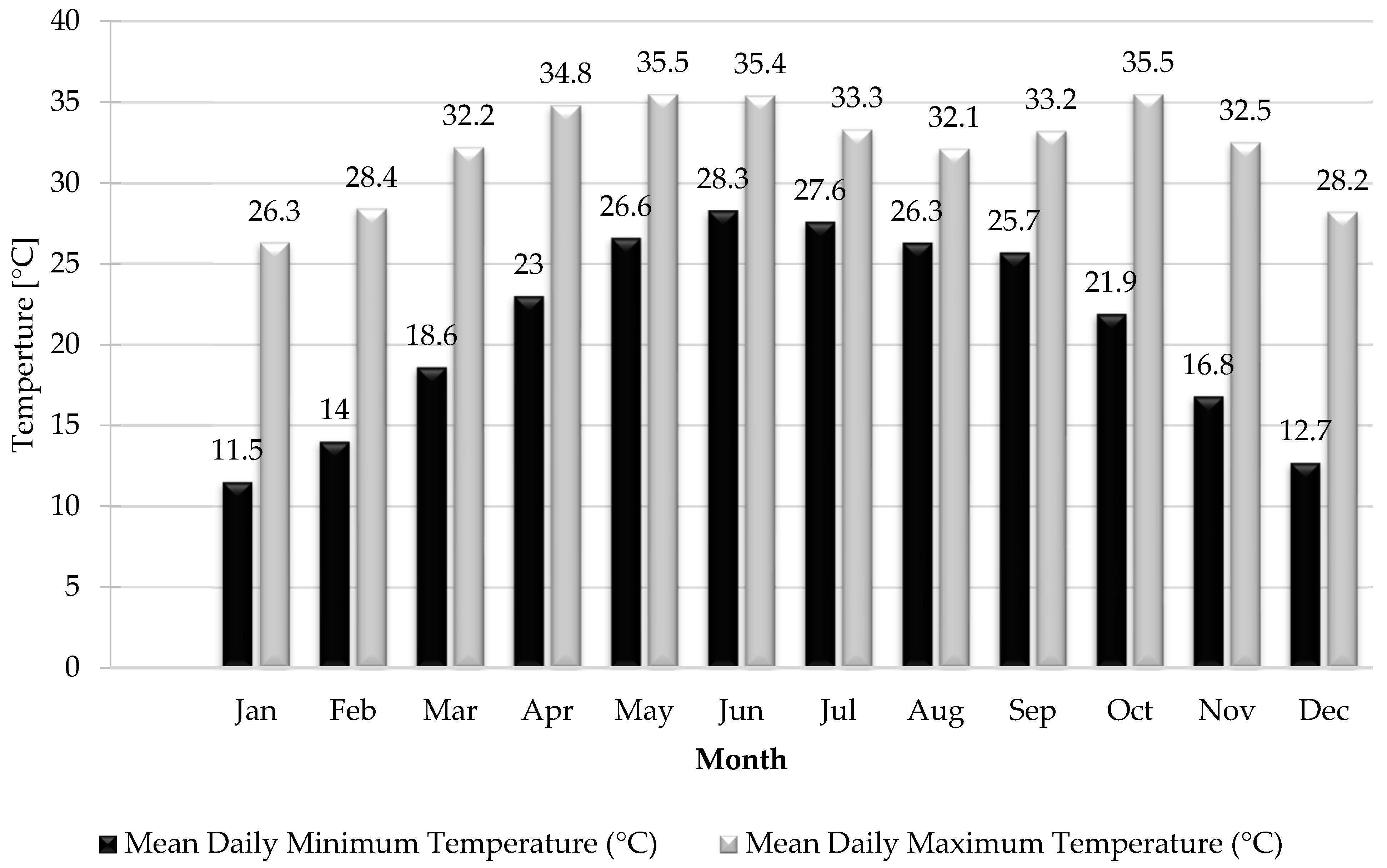
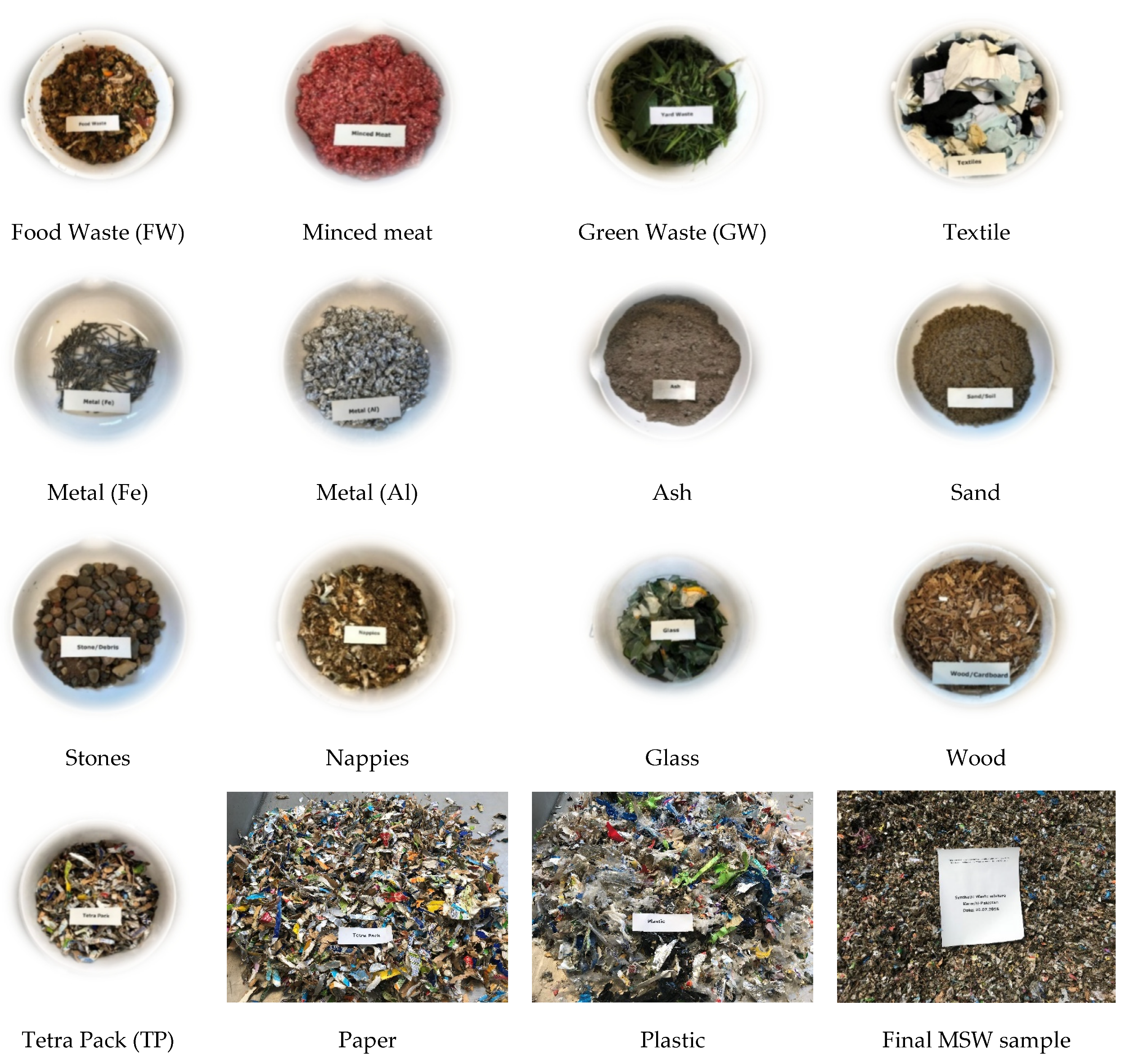
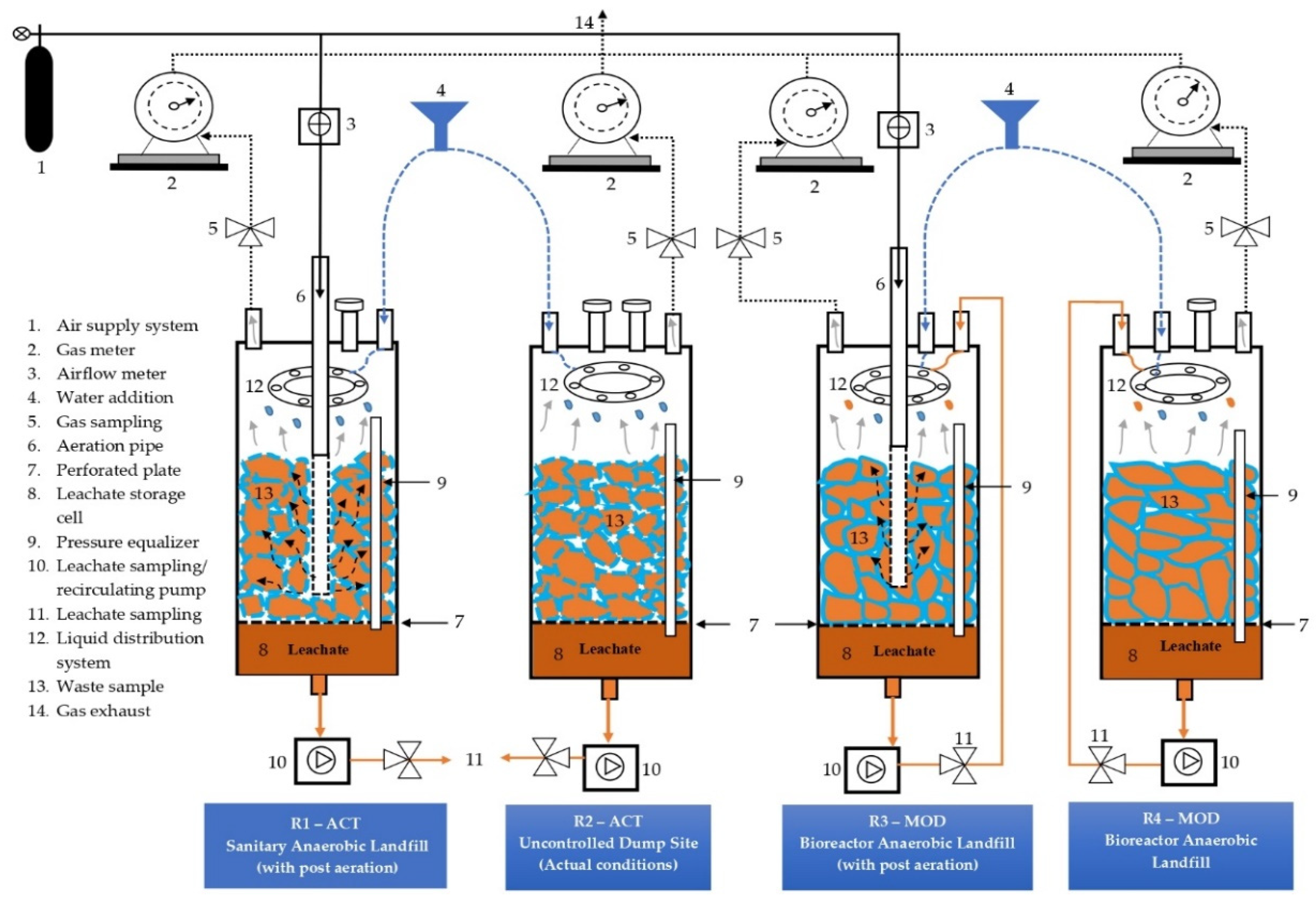
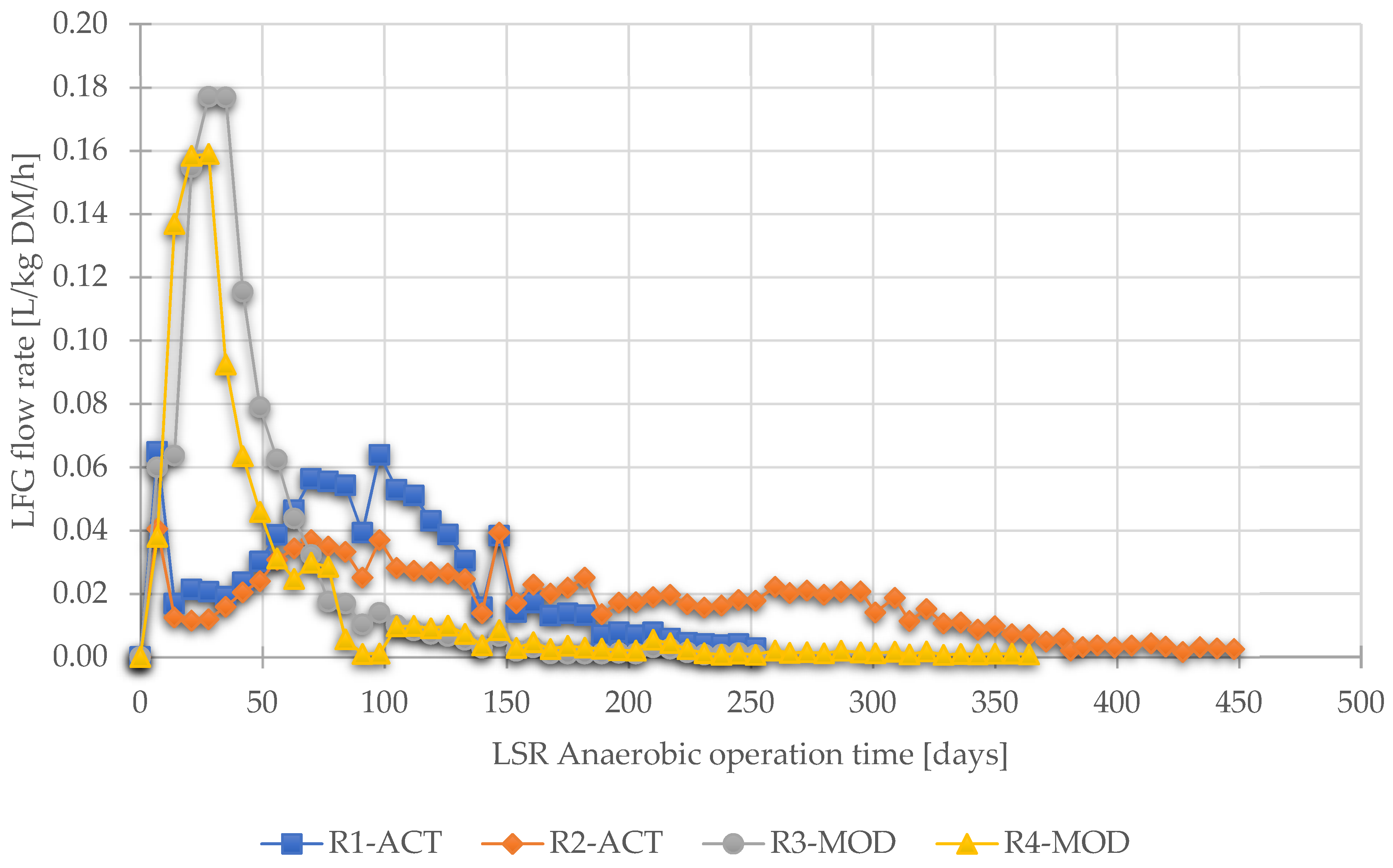
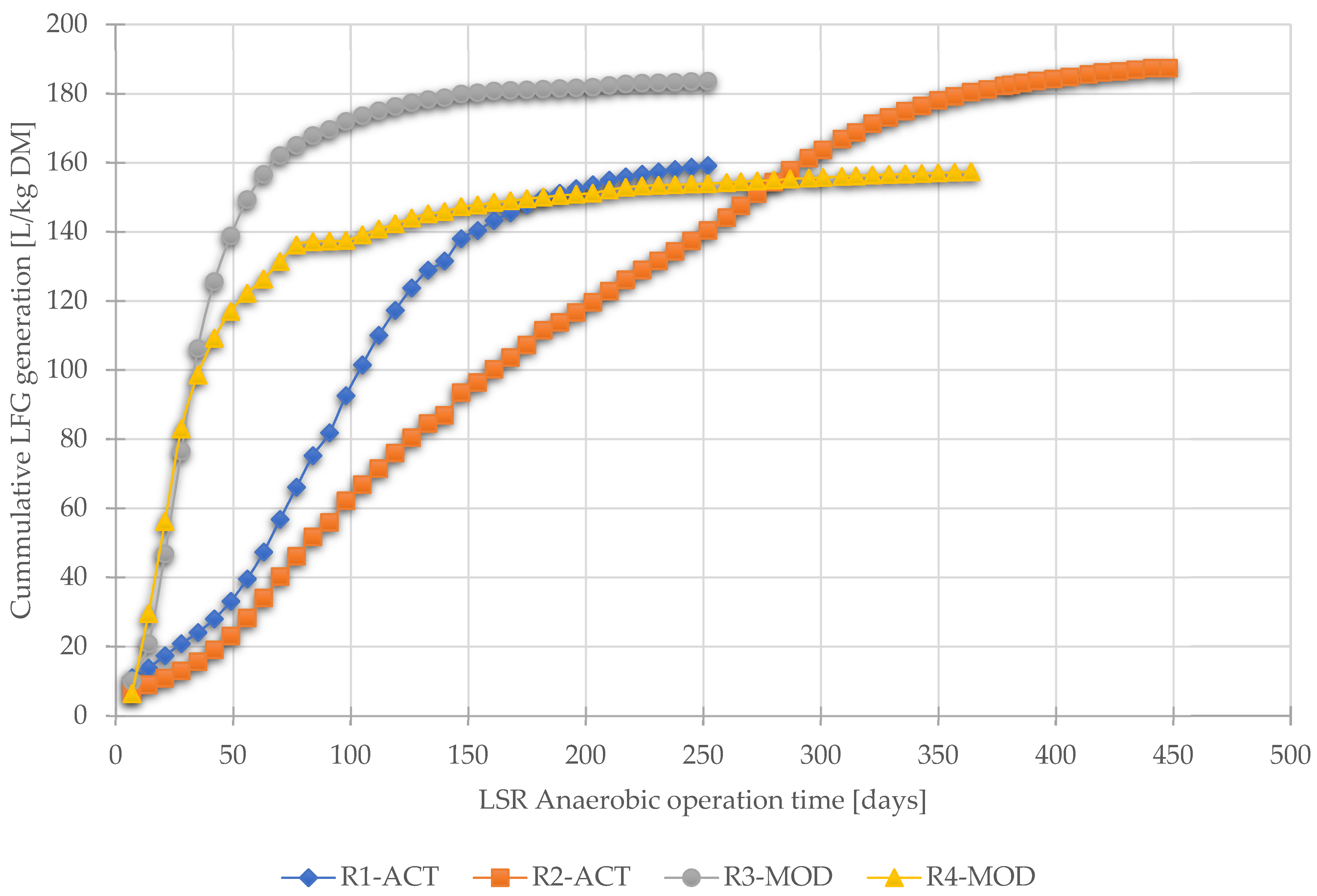


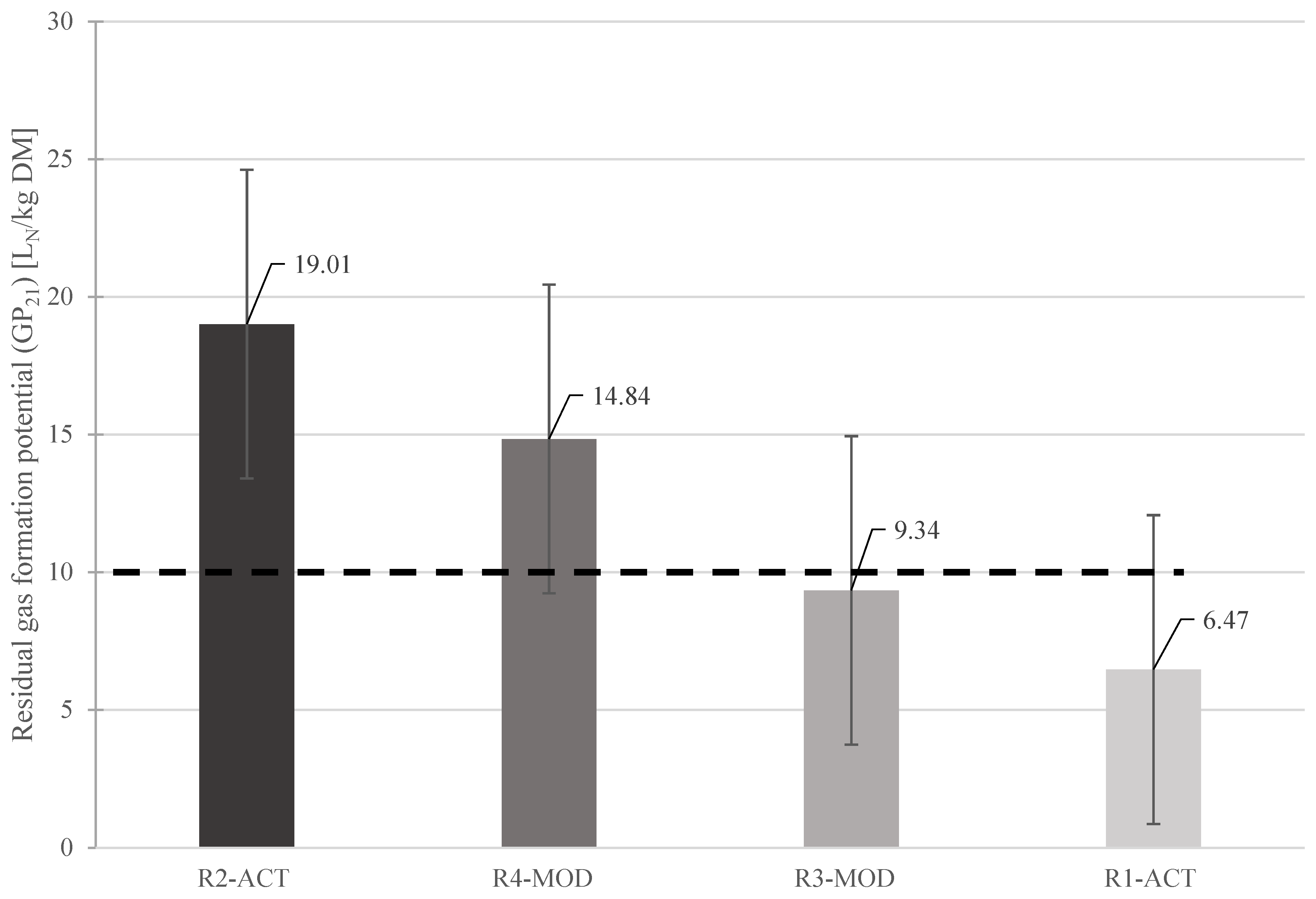
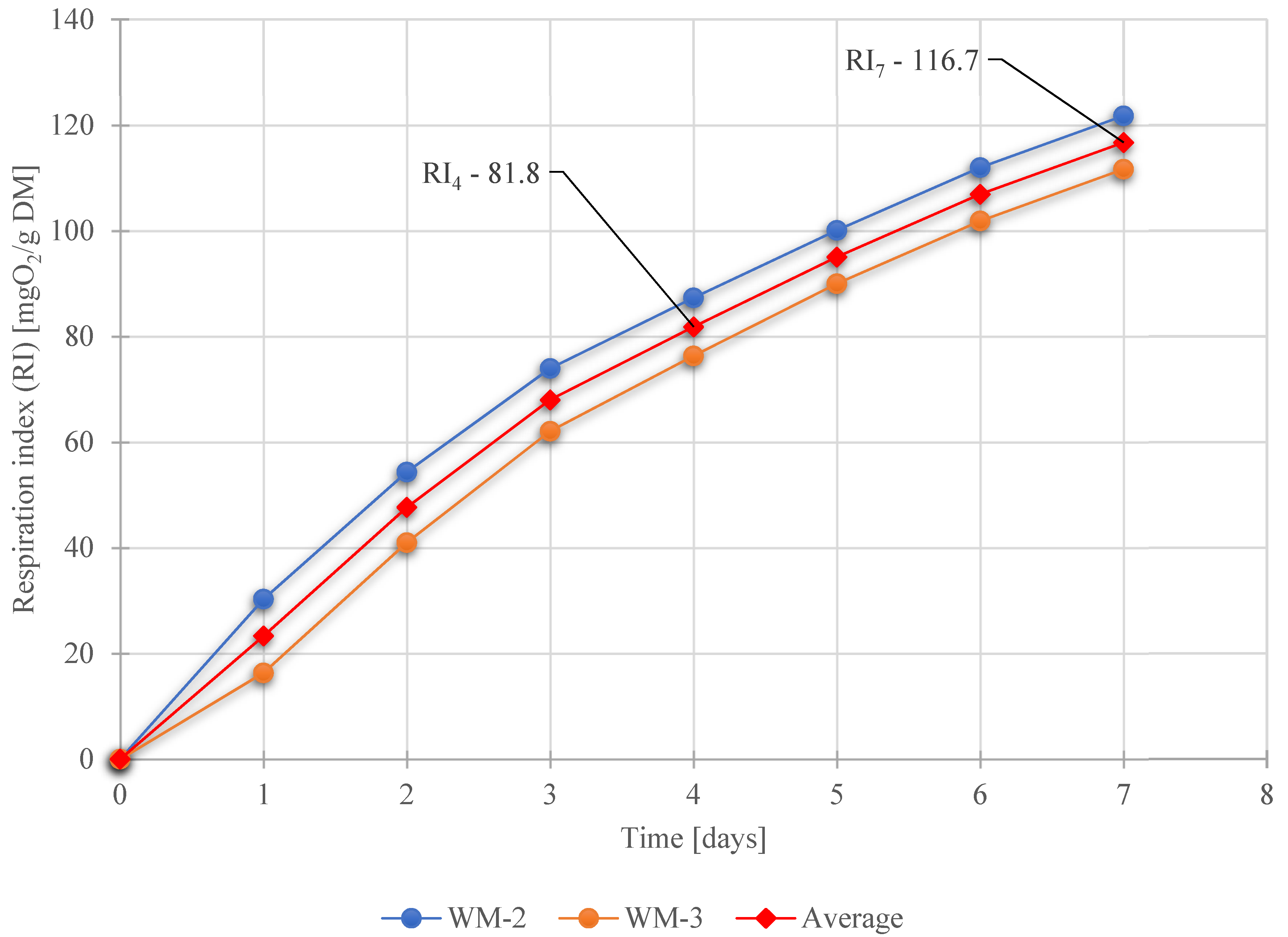

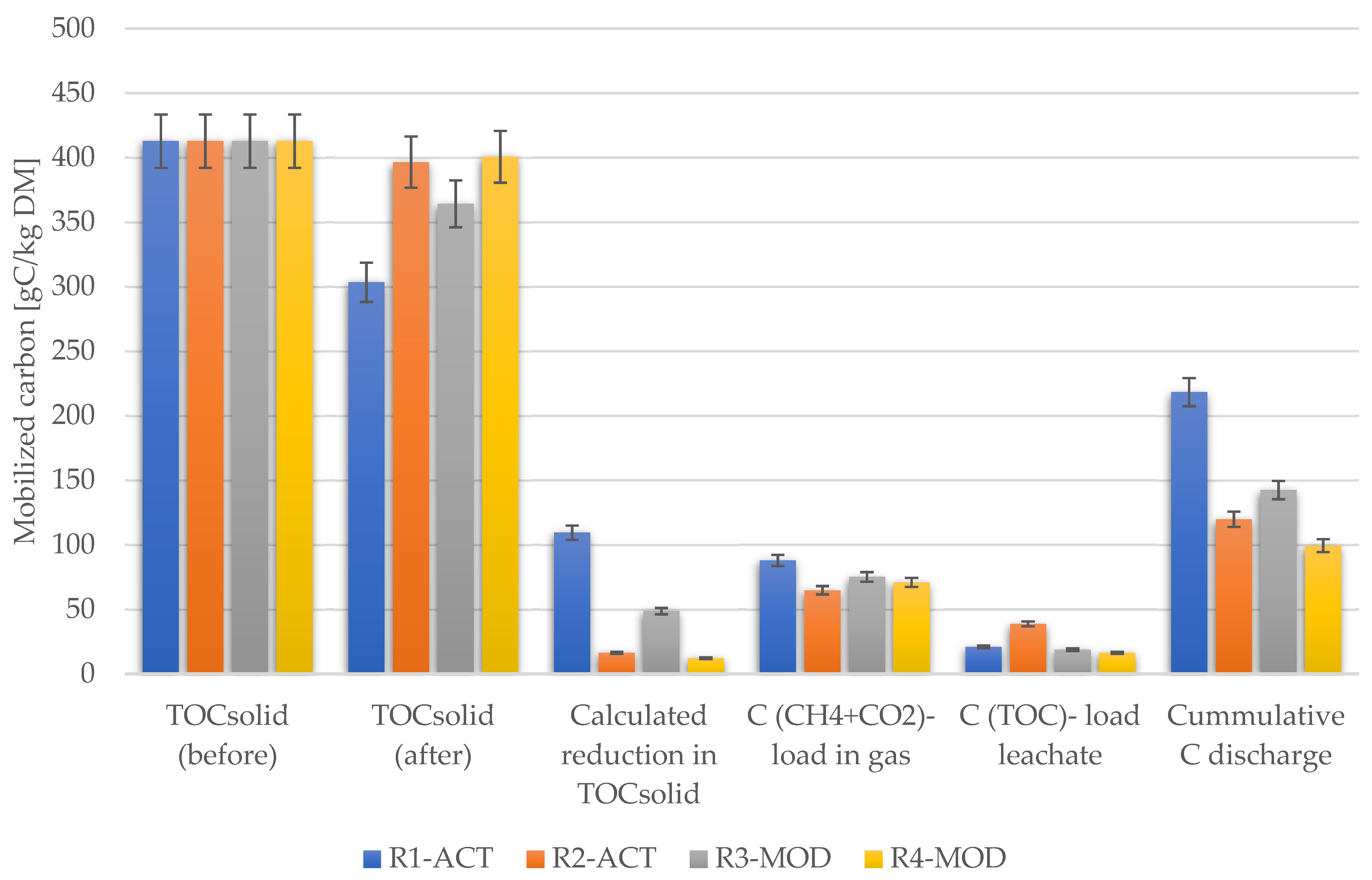
| Waste Component | FW | GW | Paper | Glass | Metal | Plastic | Fines | Nappies | Textile | TP | Wood |
|---|---|---|---|---|---|---|---|---|---|---|---|
| Fraction in sample [% w/w] | 26.1 | 17 | 8 | 5.6 | 1.1 | 8 | 3.7 | 9.8 | 7.6 | 10 | 3.1 |
| Sample | Total Solids—TS | Volatile Solids—VS | Total Carbon—TC | Total Organic Carbon—TOC | Total Kjeldahl Nitrogen—TKN | Particle Size |
|---|---|---|---|---|---|---|
| (% Fresh mass) | (% Dry mass, DM) | (% DM) | (% DM) | (mg/g DM) | (mm) | |
| Fresh MSW | 44.4 | 82.8 | 41.42 | 41.28 | 20.8 | ≤25 |
| LSR# | Waste Mass (Wet) | Waste Mass (Dry) | Waste Volume | Density (Wet) | Density (Dry) |
|---|---|---|---|---|---|
| [kg] | [kg] | [L] | [kg/L] | [kg/L] | |
| R1-ACT | 2.80 | 1.24 | 4.52 | 0.62 | 0.28 |
| R2-ACT | 3.00 | 1.33 | 4.16 | 0.72 | 0.32 |
| R3-MOD | 3.40 | 1.51 | 4.65 | 0.73 | 0.32 |
| R4-MOD | 2.80 | 1.24 | 4.26 | 0.66 | 0.29 |
| Average | 3.00 | 1.33 | 4.40 | 0.68 | 0.30 |
| LSR# | Duration [Days] | Aeration Rate [L/kg DM/d] | Water Recirculation | Leachate Analysis | Water Exchange | Off Gas Analysis |
|---|---|---|---|---|---|---|
| All | 16 | 145 | Twice per day | Once a week | No | Twice per week |
| Operation | Unit | R1-ACT | R2-ACT | R3-MOD | R4-MOD |
|---|---|---|---|---|---|
| Anaerobic (An-A) | [days] | 252 | 448 | 252 | 364 |
| Post-aeration (Post-AE) | [days] | 196 | - | 112 | - |
| Total operation time | [days] | 448 | 448 | 364 | 364 |
| Average water addition | [mL/week] | 56 | 56 | 165 | 165 |
| Leachate recirculation | [daily] | - | - | Twice | Twice |
| Aeration rate (Post-AE) | [L/kg DM/day] | 8.28 | - | 6.87 | - |
| Parameter | Value | Unit | Reference |
|---|---|---|---|
| Results of lab-scale experiment | |||
| Landfill gas production | 187 | m3/tonne DM | Present study |
| Methane fraction in LFG | 57.1 | % | Present study |
| Methane production | 106.8 | m3/tonne DM | Present study |
| Amount of MSW annually disposed | |||
| Total MSW generation | 15,600 | tonnes/day | [24,33] |
| Moisture content | 55 | % | Present study |
| Waste disposal rate | 70 | % | [45] |
| MSW disposal | 10,920 | ||
| Waste dry mass disposal | 6006 | tonnes/day | |
| 2,192,190 | tonnes/year | ||
| 2.2 | Million-tonnes/year | ||
| GHG emissions from MSW annually disposed | |||
| Methane quantity | 234,075,471.6 | m3/year | |
| 234.1 | Million-m3/year | ||
| Density of methane | 0.66 | kg/m3 | |
| 154,489,811.3 | kg | ||
| 154,489.8 | tonnes | ||
| 0.15 | Million-tonnes | ||
| GWP of methane | 25 | CO2-eq | [79] |
| Specific GHG emission | 1.8 | tonnes CO2-eq | |
| Total GHG emissions | 3.9 | Mt CO2-eq |
| Parameter | Unit | Fresh Sample | R1-ACT | R2-ACT | R3-MOD | R4-MOD |
|---|---|---|---|---|---|---|
| Waste mass—initial | [kg] | 2.8 | 3 | 3.4 | 2.8 | |
| Waste mass—final | [kg] | 1.06 | 1.88 | 2.8 | 2.4 | |
| TS | [%] | 44.42 | 33.24 | 36.03 | 26.7 | 26.04 |
| VS | [%] | 82.85 | 56.74 | 74.09 | 62.34 | 69.54 |
| TOC | [%] | 41.28 | 30.34 | 39.65 | 36.42 | 40.06 |
| GP21 | [LN/kg DM] | 251.9 | 6.47 | 18.88 | 9.34 | 14.35 |
| BMP21 | [LN/kg DM] | 170.1 | 3.45 | 9.87 | 4.36 | 7.01 |
| Degree of Decomposition | [%] | 0 | 72.1 | 48.5 | 61 | 37.5 |
| RI4 | [mgO2/g DM] | 81.8 | 2.02 | 3.04 | 3.06 | 3.40 |
| RI7 | [mgO2/g DM] | 116.7 | 2.55 | 5.30 | 4.54 | 4.87 |
| Calorific value | [J/g] | 19,120 | 13,508 | 16,951 | 16,268 | 17,937 |
Publisher’s Note: MDPI stays neutral with regard to jurisdictional claims in published maps and institutional affiliations. |
© 2022 by the authors. Licensee MDPI, Basel, Switzerland. This article is an open access article distributed under the terms and conditions of the Creative Commons Attribution (CC BY) license (https://creativecommons.org/licenses/by/4.0/).
Share and Cite
Sohoo, I.; Ritzkowski, M.; Guo, J.; Sohoo, K.; Kuchta, K. Municipal Solid Waste Management through Sustainable Landfilling: In View of the Situation in Karachi, Pakistan. Int. J. Environ. Res. Public Health 2022, 19, 773. https://doi.org/10.3390/ijerph19020773
Sohoo I, Ritzkowski M, Guo J, Sohoo K, Kuchta K. Municipal Solid Waste Management through Sustainable Landfilling: In View of the Situation in Karachi, Pakistan. International Journal of Environmental Research and Public Health. 2022; 19(2):773. https://doi.org/10.3390/ijerph19020773
Chicago/Turabian StyleSohoo, Ihsanullah, Marco Ritzkowski, Jinyang Guo, Kiran Sohoo, and Kerstin Kuchta. 2022. "Municipal Solid Waste Management through Sustainable Landfilling: In View of the Situation in Karachi, Pakistan" International Journal of Environmental Research and Public Health 19, no. 2: 773. https://doi.org/10.3390/ijerph19020773
APA StyleSohoo, I., Ritzkowski, M., Guo, J., Sohoo, K., & Kuchta, K. (2022). Municipal Solid Waste Management through Sustainable Landfilling: In View of the Situation in Karachi, Pakistan. International Journal of Environmental Research and Public Health, 19(2), 773. https://doi.org/10.3390/ijerph19020773








